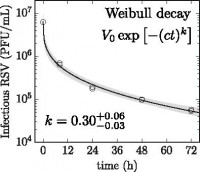Uncovering critical properties of the human respiratory syncytial virus by combining in vitro assays and in silico analyses

When a virion is left in a liquid medium over some time, it loses its ability to infect cells. This is often because the virion surface proteins become deformed, e.g. because of heat or the ionic content of the medium, such that they can no longer effectively bind cells and infect them. For many viruses (e.g. influenza, HIV and hepatitis C) this loss of infectivity over time follows an exponential.
In this paper, we evaluated the rate at which the respiratory syncytial virus (RSV) loses infectivity over time. We were surprised when we found that the loss of infectivity of RSV in our data did not follow an exponential. We used a Weibull distribution to describe the decay and estimated its shape parameter to be k=0.30 [95% credible region: 0.27-0.36], which means the rate of decay gets smaller over time. This is typical of a bad production system wherein a lot of defective products are made which fail soon after production, leaving only well-made products which become defective at a lower rate. In a 2013 paper, Liljeroos and others (doi: 10.1073/pnas.1309070110) showed that as RSV buds from the surface of the cell, bud pinching (closing the bud to free the virion from the cell) is physically difficult, and often leads to misformed buds. The bad structure leads the filamentous (worm-shaped) RSV bud to “plop” outwards (become spherical), flip its surface F proteins (responsible for RSV attachment to host cells) from their pre-trigger (very infectious) to their post-trigger (poorly infectious) state. This is consistent with our finding of k<1, wherein RSV that don’t pinch their bud properly upon cell exit fail (lose infectivity) very early on, and the remaining RSV population which pinched properly will decay following a much less steep exponential.
- Reference
- Catherine A. A. Beauchemin, Young-In Kim, Qin Yu, Giuseppe Ciaramella, John P. DeVincenzo
"Uncovering critical properties of the human respiratory syncytial virus by combining in vitro assays and in silico analyses"
Journal Reference: PLoS ONE 14(4): e0214708 (2019)
doi: 10.1371/journal.pone.0214708

